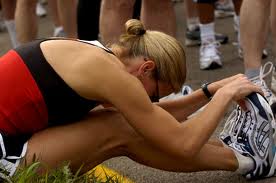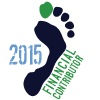
Stop Stretching!By Dr. Stephen GangemiThe Sock Doc
Stretching is perhaps one of the most controversial fitness subjects of present day. Passionate debates arise between those who perceive the benefits of stretching and those, like me, who think stretching is one of the worst activities you can partake in, especially if you’re already injured. It’s a tradition that’s hard to break because so many of us have the stretching necessity ingrained in our heads as we’ve listened to coaches, trainers, professional athletes, researchers, and doctors throughout our fitness lives. Although research showsstretching has no value and may actually cause harm, people find it difficult to “Just Say ‘no’ to stretching.”

I don’t stretch. I’ve never advised any patient, athlete, or anyone who cares about their health to stretch. I am in very good health and have very good fitness. Although I don’t stretch at all, I’m rather flexible. This is because flexibility is a reflection of health and fitness, not stretching. I had two interesting experiences over the past couple years with coaches I hired for a bit to help me with my swimming and cycling techniques. The swim coach noticed I was not extending my arm out far enough in the water and therefore not grabbing as much water as I could be. Essentially I was not making myself as long as I could be and streamlining through the water. So he pulled me out of the pool and showed me what to do on land. He commented on how I was too tight and needed to stretch my arms out more to get the length I was looking for. But when I was able to do on land what he wanted me to do in the water he was amazed I could lengthen my body (arm) out so much. I was not inflexible, I just had poor swim technique, and that needed correction. My cycling coach was also surprised when he was checking my flexibility to adjust my bike position. His initial comment was that I must stretch a lot as I was pretty flexible for someone who can remain in a bent over aero position on a bike for five or more hours. I still don’t think he believed me when I told him I never stretch. I did stretch a lot in high school – before cross country practice, a lot in wrestling practice, and on my own. I was injured a lot. When I wasn’t injured, I was still having some muscular issue somewhere. Now I subscribe to my no stretching, no injuries program.
The thought that stretching relaxes and is therapeutic for tight muscles is not only a misconception, it has never been proven. It actually weakens muscles, and that’s definitely not a good thing. Muscle tightness is due to an imbalance. The imbalance lies within the neuromuscular system – so it is a reflection of the nervous system via the muscular system. The idea that many physicians, therapists, coaches, and athletes have that you need to stretch a tight muscle to relax it and exercise a neurologically weak muscle to strengthen it is incorrect. It sounds nice, but your body doesn’t work that way. Clinicians who evaluate muscle function in athletes observe that stretching a muscle could make it longer and increase flexibility but this resulted in a reduction in function from a loss of power. “There is a neuromuscular inhibitory response to static stretching,” Malachy McHugh, the director of research at the Nicholas Institute of Sports Medicine and Athletic Trauma at Lenox Hill Hospital in New York City, told the New York Times. “The straining muscle becomes less responsive and stays weakened for up to 30 minutes after stretching, which is not how an athlete wants to begin a workout.”
A study done at the Department of Kinesiology at the University of Texas compared changes in muscles that were stretched and not stretched in the same person. They found that stretching one muscle can also impair another muscle that was not stretched, possibly through a central nervous system inhibitory mechanism. That means that stretching (and weakening) a muscle in your left leg could weaken a muscle in your right leg that you didn’t even stretch!
Other studies show adverse effects on lower limb power, sprinting ability, and vertical jump. These abnormal changes induced in a stretched muscle can last for an hour or longer, and some clinicians have demonstrated that stretching can cause prolonged muscle problems that can last days and weeks. Yet despite these findings, track sprinters, high jumpers, and other athletes that rely on jumping power including basketball players still feel the need to stretch.
Some people don’t agree with the fact that stretching causes muscle weakness because they don’t feel weak after stretching. This is because most people feel the tight part of muscle imbalance and usually don’t feel muscle weakness until it begins affecting a joint or unless it’s severe enough to reduce muscle power. So you might feel your hamstring to feel tight and the need to stretch it, but typically the weakness is in the antagonist muscle, in this case the quadriceps. Stretching the hamstrings will further weaken that “tight” muscle and perhaps temporarily provide symptomatic relief, but the problem will only continue to spiral downward.
So what causes muscle imbalances and the feeling of tight muscles and the need to stretch? Well, muscle imbalances occur for many reasons but ultimately there is some stress to the nervous system, either systemically (throughout the entire body), or locally. For example, if you injure your hamstring this may inhibit the function of that muscle so it hurts. You may perceive the weakness as pain in the area or you may have pain and/or tightness on the opposite side, in the quadriceps, as it tries to compensate for the hamstring weakness. You inclination would then be to stretch the quads to “relax” them, but the problem is really in the hamstrings; that is the area that needs to be addressed. Doing hamstring exercises won’t strengthen the muscle because that doesn’t effectively deal with the injury. So you can do hamstring curls or some other exercise all day long and it won’t turn the hamstrings on any more than stretching will relax the quadriceps.
Typically in this case, the best thing you can do to turn on the hamstrings is apply deep pressure manipulation – also known as origin-insertion technique or trigger point therapy – to the areas of injury and the tendon attachments. Stretching does not help injuries because it elongates the muscle fibers. That is not helpful or healing for injured muscles. When there is an injury, the fibers are already elongated and pulled away from another or in some other configuration than what they should be in order to properly heal. Stretching will only make this worse. Using trigger point therapy can help those fibers line back up and heal properly. Feel around with deep pressure throughout the muscle, from the belly to both ends, looking for very tender “hot” spots. Hold them and/or rub them out with deep pressure in a slight circular motion for 15-30 seconds. Your therapist or doctor may need to assist you w
ith this and they may need to perform other types of therapies to help your injured muscle heal and “turn on.” Please note that this is not advice to necessarily treat yourself. Use common sense. If you have a major muscle pull or tear, or obviously if you aren’t healing, you should seek the advice of a professional.
Then there is the systemic issue where an individual muscle, or group or muscles, feels very tight. Maybe your whole body feels tight and you have a stretching routine to “loosen you up” every morning. In this case, there is something affecting your entire nervous system, and the muscles are reacting to whatever the problem is. Most often these are dietary/nutritional problems. If there is a lot of inflammation in your body, perhaps from eating too many processed vegetable fats such as corn, soy, safflower, and peanut oil, this can result in tight muscles throughout your body. Eating any amount of partially hydrogenated “trans” fats can also result in a similar problem. A high carbohydrate diet, especially one containing refined sugars, can also make your nervous system more stressed and your muscles feel tight. Too much caffeine, and especially the excitotoxins MSG and aspartame (Nutrasweet) often will give you the muscle aches and tightness along with many other health problems. Of course, stretching will not help any of these problems though it may provide temporary relief.
Hormonal imbalances can also make your nervous system react in such a way that you have muscular tightness and feel the need to stretch. Women who have estrogen dominance (and low progesterone), and men with low testosterone levels may experience a tight lower back and hip region, giving them the inclination to want to stretch those areas out. Thyroid and adrenal gland hormone imbalances can result in similar problems too.
Your fascia – the connective tissue that holds everything together in your body like Saran Wrap -can sometimes be tight because of an injury to the body but also due to low vitamin B12 levels. This is common in vegetarians who often lack B12 which is found in eggs and animal products. Also individuals under significant stress will lose the necessary intrinsic factor in the stomach needed to properly absorb B12 – resulting in tight connective tissue and muscles – and the need to stretch. As with the other cases, fixing the cause of the problem, in this case the stress situation or the B12 deficiency will “loosen up” the muscles, not stretching.
But what if you’re not injured? The same rules apply. Typical stretching routines will still weaken muscles and promote injury. Consider why you need to stretch. Or do you enjoy stretching and want to do it? Wanting to stretch because it is relaxing to you may be okay, if done properly, (as described below). Many stretches we were all taught in gym class and by our coaches are not only useless, they’re harmful. Joint instability and muscular weakness often results with many of these types of stretches – think about that Hurdlers Stretch – it’s perhaps the worst one out there.
Yoga? Let’s first say that yoga and stretching are not the same thing, yet many people associate the two because that is how it has unfortunately evolved in many areas. Most yoga classes today have students trying to force themselves into a yoga pose they are not ready to do and they overstretch. This is Westernized yoga and not the way it was intended to be. Yoga is intended to relax the entire body with certain poses and deep breathing resulting in inner harmony and focus on one’s self, not to stress your body out by stretching it in shapes you are not ready or able to do. So yoga may be beneficial if performed in a controlled fashion, within your means, and within the yoga philosophy.
Dancers and gymnasts are perhaps one exception to anti-stretching. For many of these individuals, stretching is necessary to some degree as their activities require a larger range of motion than is needed in order to perform their activities. The static stretching for these individuals should still be handled very carefully, ideally contracting the antagonist muscle to prevent overstretching. This would mean if a dancer was working on a bar and stretching his or her hamstrings, he or she would contract the quadriceps muscles, hold for up to thirty seconds, and repeat for at least three times. An active aerobic warm-up for at least 10 minutes is essential. However, I can say from my experience with professional dancers they always feel the need to stretch more than they need to because of underlying problems – most often dietary inadequacies, nutrient imbalances, and injuries make their muscles “more tight.” Once the underlying problems are resolved theses performers feel much more limber and less of a need to stretch, yet they’re much more flexible.
We associate flexibility with health. This is true to some extent but more does not necessarily mean better. If you can’t touch your toes while standing with your knees locked out it doesn’t mean you are not healthy. Sure there is a “normal” but it is hard to say what that is and it’s different for everybody. If you can’t touch your knees while bending forward you’ve got a problem somewhere – or too short of arms! More important is the balance and symmetry between muscles, including side to side. If your right leg can be stretched out to the side 90 degrees and your left can only go 80 degrees then that indicates a problem. You’re probably thinking the problem is on the left because that is how we were taught to think; but not necessarily so. Sometimes the area, in this case the leg, can be too flexible and once muscular and nervous system imbalances are corrected the 90 degree leg might only go to 80 degrees. And often when this happens the person feels more balanced and limber. So don’t think more is better. Balance is better.
Stretching may increase your flexibility, but you will most likely be weaker and the results are often short-lived. Saying that stretching reduces injuries or improves endurance performance, (the two main reasons given for stretching), is like saying certain shoes will make you run or jump faster. Many continue to make both these claims, yet neither has ever been proven, and many still buy the shoes and stretch with them on. Stretching is not exercise and not a warm-up before a run or any activity. Aerobic activity is the best warm-up as it increases flexibility in a safe way while improving oxygen utilization, lung capacity, and fat burning.
So balance your muscles and your entire body by balancing your life with proper exercise, diet, and other lifestyle factors. Stop drinking that Kool-Aid propaganda and just say “No!” to stretching!




























